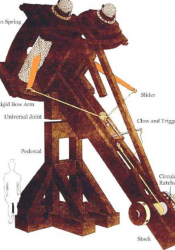The Torsion Catapult
Transitioning from the Flexible Bow catapult 50 years prior, the increasing interest in the utility of the catapult lead to the subsidization of the next phase of this devastating weapon, the Torsion Catapult. Commissioned by Philip of Macedon, the father of Alexander the Great, around 350 B.C., the newly developed catapult utilized what is referred to as the torsion principle, a system which requires tightly wound fibers being drawn to a notched pull. This specific catapult apparatus significantly improved the range and precision of the previous catapult design and was largely unchanged for many centuries. With slight adjustments deriving from physicists and engineers such as Philo of Byzantium, Archimedes of Syracuse, Hero of Alexandria, and Vitruvius of Rome, the torsion catapult was able to transition from launching arrows the size of light javelins and handheld stones to projectiles weighing as much as 78 kilograms. Moreover, according to Vitruvius, these catapults, when unloaded, were capable of weighing 162 kilograms and most commonly launched projectiles ranging from 13 to 26 kilograms at a range of 640 meters. With their high degree of intrinsic accuracy and wall-penetrating power, historical commanders ranging from Alexander the Great to Julius Caesar were known for utilizing these weapons in significant historical battles such as the siege of Gaza in 332 B.C., the Roman siege of Syracuse from 213 to 211 B.C., and the siege of Jerusalem in 63 B.C.
With the advent of this creative weapon, shifts in politics and society arose. Firstly, the increased mechanization of warfare displaced the human-to-human contact and denounced the personability of war as one’s emotional investment in eliciting physical violence was replaced by strategic aerial assault tactics. This increased separation of battling forces was noted by Philo of Byzantium in 200 B.C. as he claimed, in his artillery manual, that a wall had to be at least 4.62 meters thick to withstand catapult stones and that the minimum distance to maintain between the walls of a defensive fortress and a catapult should be at least 150 meters. Thus, by noting that a wall-reducing device was now readily available in warfare, new social constructs had to be developed in order to preserve social living space. For example, Aristotle, in the mid-4th century B.C. was quoted in suggesting that the newly popularized quadrilateral city blocks of ancient civilizations be combined with the prior, ancient landscapes, such as motes, inner-city defense walls, and ditches, in order to maintain structural composition of these newly developing cities when subjected to the decimating force of invading catapults. Conversely, the introduction of the torsion catapult also significantly redefined the Eurasian political landscape as Alexander the Great’s successfully dominating conquest was considerably assisted by his use of this optimized weapon. With the development of the catapult proving to be an imperative military marvel, the equality of arms in warfare was lost and the technical skills necessary to operate mechanical weapons foreshadowed the first differentiations of status amongst military operations. Moreover, the specialized knowledge in mathematical and technical skills required to construct and maintain catapults thus increased the social status of catapult engineers as military experts and allowed them to survive political purges.
Sources:
International Symposium on History of Machines and Mechanisms : Proceedings of HMM 2008, edited by Hong-Sen Yan, and Marco Ceccarelli, Springer, 2009. ProQuest Ebook Central, http://ebookcentral.proquest.com/lib/purdue/detail.action?docID=417096. Created from purdue on 2019-05-09 18:07:26.
Yurtoğlu, N. (2018). Http://www.historystudies.net/dergi//birinci-dunya-savasinda-bir-asayis-sorunu-.... History Studies International Journal of History, 10(7), 241-264. doi:10.9737/hist.2018.658

